January 30, 2024
Envision a body part vast enough to encircle the globe, yet so thin it’s microscopic. Now, imagine a tiny molecule — that earned scientists a Nobel Prize for its discovery as a biochemical messenger — optimizing blood flow, appearing and disappearing in a blink.
You’ve just met the dynamic duo: the endothelial glycocalyx (EGX) and nitric oxide (NO) — the unsung heroes of vascular function.
Your body is a symphony, and the conductor orchestrating this harmonious masterpiece is your vascular system. It’s your literal lifeline, but most people never think about it, even though ignoring it can result in catastrophic health issues.
Today, I’m taking you on quite a journey to help you fully understand the EGX, nitric oxide, and the vascular system. By the end of this article, you’ll discover vital health-optimizing insights like:
- The reason your vascular system acts as your body’s maestro
- The pivotal role played by the endothelial glycocalyx
- The significance of nitric oxide
- How to harness nitric oxide for optimal vascular (and overall) health
Ready to dive in?
What Is the Endothelial Glycocalyx?
These two scientific images show cross-sections of a blood vessel, with the dark black, hair-like projections displaying the endothelial glycocalyx.
The endothelial glycocalyx (EGX) is a dynamic, responsive structure that acts as the first line of defense for your endothelium — a large organ vital for keeping your blood flowing. The EGX is made from a delicate mesh of proteins and sugars. Microscopically thin, it determines what gets into your endothelium and stays in the bloodstream. That means the nutrients you consume reach their destination while keeping harmful substances at bay. It also plays a crucial role in blood clotting, responding to vascular insults, and maintaining vessel health.
Now here’s what you need to know from a practical point of view: The EGX, despite its resilience, is vulnerable.
It’s all too easy to stress this vital structure, and that can lead to a cascade of health issues. The trouble is, you can’t feel if your EGX is going down. You’ll only know about it when you run into serious problems with your cardiovascular health.
However, when you take proper care of this essential structure, you can look forward to:
- Improving nutrient delivery from the food you eat and the supplements you invest in
- Enhancing blood circulation — think about fitness and your sexual life
- Fortifying your natural defenses against disease
Your Vascular System: A Quick Tour
In this section:
- Discover more about the arteries, veins, and microvasculature
- Meet the EGX and uncover how it works
- Understand why the EGX matters
To comprehend how crucial this minuscule structure is, you first have to take stock of the vascular system itself. The organs, function, and action in your body depend on the blood flowing around it, which relies on a healthy EGX.
I’ll start with the arteries and veins, which is what comes to mind for most people when they think of their vascular system.
- Arteries are the freeways of your blood’s transport system. They do the critical job of transporting oxygen-rich blood from the heart to various body tissues. This process is pivotal for delivering nutrients and maintaining blood pressure.
- Veins return deoxygenated blood to the heart (sans pulmonary veins, which carry oxygenated blood). Veins are less muscular than arteries. A unique feature of veins, particularly in the extremities, is the presence of valves. These valves are incredibly important, because they prevent the backflow of blood, ensuring that it all heads in one direction toward the heart.
Picture your arteries as the powerhouse offensive team, delivering that precious, oxygenated blood exactly where it needs to be. Now, your veins? They’re the defensive line, diligently sending deoxygenated blood back to the heart, ensuring the whole cycle stays in perfect harmony.
But here’s the kicker — neither team likes disruptions, meaning it’s ridiculously easy to mess with your arteries. Indulging in that second piece of cake or the wrong kinds of fats, sitting on the couch for too long, puffing away on cigarettes, and letting stress run wild are all villains in artery health.
Yet, as I mentioned previously, inside every artery and every vein, is the EGX — the ultimate MVP. I’ll be taking a closer look at that in a minute, but first, let’s take a deeper dive into the vascular system.
Your 60,000-Mile-Long Vascular System
The total network of all blood vessels in your body extends an astonishing 60,000 miles — a distance that is equal to more than two trips around the Earth.
Think about your microvasculature as tiny roots growing intuitively in the areas where more oxygen and nutrients are needed.
Comprising the tiniest blood vessels found throughout your muscles, tissues, and organs, particularly in your eyes, kidneys, brain, sexual organs, and extremities, this intricate network undergoes constant renewal through angiogenesis, where new blood vessels form and old ones fade away. This perpetual cycle represents a vital exchange between your bloodstream and the entirety of your body. Notably, this process proves invaluable in healing tissue injuries and responding to low oxygen levels.
Every blood vessel in the body — from your arteries to your microvasculature — has a single-cell lining called the endothelium which is the final point of control for the exchange of substances between the blood and the rest of the body.
On top of the endothelium lies the vascular system’s hero, the EGX.
The Body’s Bouncer: Your EGX
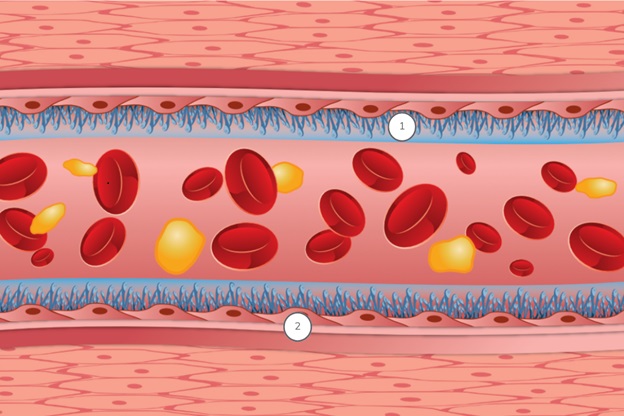
The endothelial glycocalyx is that blue layer (#1) between your endothelial cells (#2) and the flowing blood within the vessel.
The EGX is a thin, delicate, mesh-like layer with a variable thickness typically ranging from 0.5 to 5 micrometers. It’s a complex matrix composed of the following proteins and carbohydrates:
- Glycoproteins: Glycoproteins, like syndecans and glypicans, are molecules combining both carbohydrates and proteins.
- Proteoglycans: Proteoglycans are core proteins attached to glycosaminoglycan chains (GAGs) such as heparan sulfate, chondroitin sulfate, and hyaluronic acid.
Picture a dense, gel-like layer sitting between the flowing blood and the inner wall of the blood vessels. The EGX regulates the flow of blood through those vessels, including the microvasculature.
As far as your vascular health is concerned, the EGX is where the action begins, but it serves multiple vital functions, such as:
- Barrier function: The EGX regulates the passage of stuff that’s in your blood through to the endothelium and onwards into your tissues. It’s a semi-permeable barrier, meaning that it lets some things in while keeping others out.
- Anticoagulant support: The EGX houses some important molecules that support a healthy response to blood clotting.
- Antioxidant storage: You may think of antioxidants as something you get from food or supplements. Did you know your body produces its own antioxidants to fight free radical damage? One of the most important antioxidants is superoxide dismutase (SOD), which lives right there in your EGX.
- Nitric oxide: This is a big one. There’s a mesmerizing process whereby the EGX senses changes in the flow of blood, and responds by triggering the production of nitric oxide. In a moment, I’ll explain just how important that tiny molecule is for your everyday health.
Let’s explore a few of these EGX functions more deeply for a closer look into why the EGX is vital for optimal health.
The “Smart Barrier”
As I’ve mentioned, the EGX functions like an intelligent sieve. It allows the right molecules through while keeping others in the bloodstream.
Some of the stuff that gets held off are harmful microorganisms and toxins that may be swept along by your blood. There are also proteins in the blood that have no business passing through the endothelium into your tissues. The EGX blocks them, too. On the positive side, the EGX allows the oxygen and nutrients that are essential for the life of your organs and tissues. You may have heard of leaky gut — the EGX helps prevent leaky blood vessels.
The traffic through the EGX is two-way, so it also allows your body to release metabolic waste into the bloodstream where it can be carried onward to be processed and eliminated — for example, CO₂, which is constantly produced by your body’s metabolism and needs to be released.
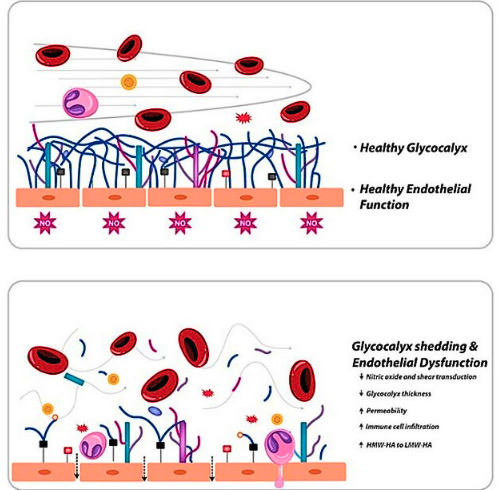
The blue lines represent the endothelial glycocalyx. In the top image, a healthy glycocalyx is keeping blood flowing. In the bottom image, the glycocalyx is shedding and endothelial dysfunction is present.
I hope you’re beginning to see just how important the EGX is for your health. To discover more insights about the EGX, check out my podcast with cardiologist Jack Wolfson.
The EGX and the Antioxidant Superoxide Dismutase (SOD)
I’ve mentioned that the EGX hosts SOD. This powerful enzyme converts a free radical called superoxide into less harmful substances. The upshot is a reduction in oxidative stress, providing critical protection for your endothelial cells.
SOD also preserves nitric oxide availability. You’ll see soon enough how critical NO is for your health and why the presence of SOD in your glycocalyx is an enormous deal.
A Bigger Picture: How the EGX Plays Out in Your Entire Body
So, what does all this talk about the EGX mean on a practical level?
Let’s break it down on several fronts:
- Heart health: Like every organ, the heart is supported by a massive network of tiny blood vessels. The health of this network is pivotal in ensuring that the heart receives the necessary nutrients and oxygen while efficiently removing waste products. Discover more about the heart in my podcast with Dr. Tom Cowan. Also, be sure to hear my wide-ranging conversation on heart disease with Stephen Hussey.
- Brain health: You won’t be surprised to learn that the EGX plays a vital role in brain health. Brain microvasculature is crucial for neuronal function as it delivers oxygen and essential nutrients to brain cells. At the same time, it efficiently clears metabolic byproducts and carbon dioxide (CO₂) from the brain, ensuring a clean and healthy environment for neurons that is free of toxins, pathogens, and unwanted intruders.
- Kidney Health: Your kidneys, dependent upon a healthy vascular system, are the guardians of healthy blood, filtering about 50 gallons a day. They also regulate your blood pressure, so saying your life depends on healthy kidneys is no exaggeration. The kidney microvasculature also manages your blood pressure through a mechanism called RAAS (renin-angiotensin-aldosterone system). The microvasculature in the kidneys is essential for filtration, nutrient reabsorption, waste secretion, and blood pressure regulation.
- Sexual Health: For men, erections occur when the penile microvasculature dilates, meaning the blood vessels widen to allow increased blood flow. The health of the endothelium, the single-cell interior wall of the blood vessels, is essential in maintaining this function. The endothelium, in turn, needs a robust EGX. Women experience microvasculature’s significance as clitoral and vaginal blood flow, which increases during arousal. This leads to clitoral erection and it also enables vaginal lubrication, both key for sexual arousal and comfortable intercourse. On the flip side, challenges with microvasculature are closely linked to sexual problems and can indicate serious health issues.
Clearly, microvasculature is essential for your heart, brain, kidneys, and sexual health — and those are just a handful of crucial examples.
Now, let’s switch gears and discuss one of my favorite topics: nitric oxide (NO). This really deserves a whole article of its own, but let’s take a look at the essentials.

Nitric Oxide — The Mighty Molecule for Vascular Health
In this section:
- Discover the key roles of nitric oxide (NO)
- Understand how your body produces NO
- How NO connects to the EGX
- What happens when NO is in trouble
As well as providing a “smart barrier” between the flowing blood and the rest of your body, the EGX triggers the production of nitric oxide, a gas that is generated and then dissipates within the blood vessels. NO plays a truly decisive role in all sorts of physiological processes in your body, with implications for vascular health, neurological function, immune response, and more.
Your body is in constant conversation with itself, and you could think of NO as a major part of the messaging network making that possible.
Known as a “signaling molecule,” NO carries messages around the body, triggering processes to happen as needed.
Here are some of the key roles of NO:
- Vasodilation: NO relaxes smooth muscles — the tiny muscles surrounding your arteries and arterioles. This leads to the dilation of blood vessels (vasodilation), enabling healthy blood flow.
- Blood pressure regulation: By modulating vascular tone — the degree of constriction or dilation of blood vessels — NO is essential to maintaining normal blood pressure.
- Neurotransmission: Up there in your brain, NO serves as a neurotransmitter, and it’s important for a range of neural processes, including memory, learning, and pain perception.
- Response to vascular insults: NO is an important player in vascular wall remodeling, thrombosis, and enzymatic production.
As for the vascular system itself, NO is crucial for maintaining the health of the endothelium, the inner lining of blood vessels. You may have heard of “stiffening of the arteries” — which is as terrible as it sounds. NO helps keep your blood vessels elastic, which is essential for responsive blood flow and healthy variations in blood pressure. NO also improves blood flow to muscles when they’re hard at work. And, as many people now recognize, NO is critical for sexual health because of its role in widening the vessels to allow more blood to flow.
Probably less widely recognized, NO levels have important implications for aging because age-related vascular changes are a key factor for longevity and healthspan.
When NO Is in Trouble
The trouble with NO is its incredibly brief lifespan, just two to six milliseconds. NO’s short lifespan makes sure its actions are highly localized, so you get targeted vascular responses wherever they’re needed. This is crucial for the quick adjustment of blood vessel diameter because you need a dynamic response to changing oxygen and nutrient demands in different body parts.
The now-you-see-me, now-you-don’t nature of NO has consequences.
It means your body needs to maintain non-stop production. If that falters, you’ll start losing all the benefits of great blood flow.
There’s another problem. NO production decreases with age — dramatically. That’s because of the decline in that enzyme I mentioned earlier: endothelial NO synthase (eNOS).
If you’re going to address the vascular health concern of nitric oxide production effectively, you need to understand how NO is produced to optimize its availability. It turns out that nitric oxide is generated in your body through multiple pathways.
PATHWAY 1: ENDOTHELIAL NO
NO is produced in the endothelium in response to the shear stress of flowing blood, a mechanical function triggered by the EGX. Several enzymes get involved, the principal being endothelial nitric oxide synthase (eNOS). This pathway produces nitric oxide right in the blood vessels.
Now, here’s an important and little-known point to note: the endothelial pathway of NO production depends on another character, hydrogen sulfide (H2S), which protects the normal functioning of eNOS. H2S, like NO, also serves as a messenger molecule and vasodilator.
PATHWAY 2: DIETARY NO
The second pathway for NO production takes place in the mouth and gut. It’s called the nitrate-nitrite-nitric oxide pathway, which follows these steps:
- It all starts when you consume inorganic nitrate, which is mostly found in beets and green leafy vegetables.
- Circulating nitrate is transported into the saliva gland and concentrated in the saliva.
- When it gets secreted in the mouth, nitrate in the saliva is reduced by specific bacteria to nitrite.
- Nitrates in the stomach can also be converted to nitrite.
- Once in the stomach, part of the nitrite is chemically reduced to nitric oxide.
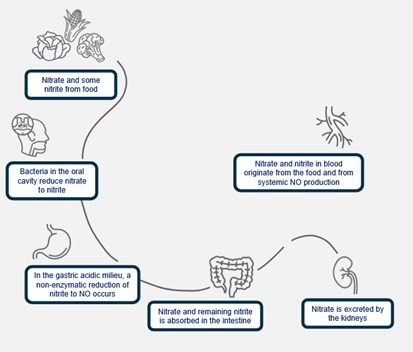
Nitric oxide is produced in various ways by different parts of the body, on demand. Since nitric oxide is a very short-lived gaseous molecule, multiple redundant pathways are a healthy adaptation to ensure nitric oxide is available when and where it is needed.
By the way, one implication is that you need to watch out for the healthy bacteria in your mouth. Be aware that mouthwash kills these bacteria, interfering with your NO production. Untreated periodontal disease also raises vascular risk.
The endothelial glycocalyx and nitric oxide demonstrate that the vascular system is a miracle of interacting components and processes, operating all day and night to keep you alive and well.
But not without its challenges, which I’ll cover one by one.
The Problem: Your EGX Is as Fragile as It Is Astonishing
Almost every problem in the vascular system — whether in the arteries, veins, or microvasculature — begins with the EGX.
As two researchers put it: “Damage to the glycocalyx precedes vascular pathology.”
When it’s under attack, the EGX begins shedding its components into the bloodstream. That protective barrier collapses and the endothelial cells are directly exposed to the flowing blood, with all its contents good and bad. This is exactly what you want to avoid.
Several factors, including internal sources within the body, external exposures, and personal behaviors, can contribute to the degradation of the EGX.
- Oxidative stress: Excess reactive oxygen species, which are unstable molecules that can damage cells, harm the components of the EGX.
- Unstable blood sugar levels and excess salt: Having too much glucose in your blood will speed up the deterioration of the EGX, as will elevated sodium levels.
- Cholesterol: High levels of low-density lipoprotein (LDL — also known as “bad cholesterol”) can harm the EGX, especially when it’s oxidized.
- High blood pressure: The mechanical stress from hypertension can weaken the EGX.
- Smoking: Toxins from tobacco directly impair the integrity of the EGX.
- Sedentary lifestyle: Sitting around too much will have a negative effect on blood flow and that can reduce the protective mechanisms of the EGX.
- Aging: The natural aging process diminishes the robustness of this protective layer, especially if you’re doing nothing to counter those effects.
The Effects of a Compromised EGX
Without a healthy EGX, there are consequences you absolutely want to avoid, such as:
- Leakage and infiltration: Blood vessels that have become more permeable can lead to the leakage and infiltration of harmful substances.
- Loss of NO benefits: After losing one of your key pathways to NO production, you may not receive all the benefits of NO, including its regulation of blood pressure and healthy blood flow.
- Compromised delivery of blood, oxygen, and nutrients: The compromised delivery of blood, oxygen, and nutrients to tissues can impact organ function.
- Interference with anticoagulant properties: Interference with the anticoagulant properties of the glycocalyx adds to your risk profile.
When you look at the EGX, you need to know what’s at stake when it gets out of whack.
Strategies for Immediate Vascular Fortification: Start Today
So, what can you do to win your battle with the vascular system?
You must know where you are to get where you want to go. In other words, you need to run the tests that will show you the current condition of your vascular system. You’ll find some fascinating information on this in my podcast with Dr. Ram Dandillaya.
First and foremost, lifestyle matters. Your vascular system is tremendously responsive to what you eat, how you move (or don’t), and the stress you carry. So, even if these principles sound familiar, they bear repeating:
- Healthy diet:
- Plenty of fruits, vegetables, whole grains, lean proteins, and healthy fats will give you the foundations of good vascular health.
- Consuming beets and leafy green vegetables is especially helpful because they contain those inorganic nitrates that your body can turn into nitric oxide.
- Other good foods are the ones that are high in omega-3 fatty acids, like fish, and those rich in antioxidants, like berries.
- You want to limit salt because too much of it can upset your blood pressure.
- Stay hydrated.
- Regular exercise: You know that regular physical activity is critical to your health. But now you know why it’s so important to your vascular system. Moving your body keeps your arteries flexible, your blood flowing through your veins, your EGX happy, and your NO production closer to ideal levels.
- No smoking: If you’re still caught in this, now’s the time to do whatever it takes to stop. There are consequences to smoking that everyone knows about, but the impact on the vascular system may be just as important. If you love your body, toss the cigarettes.
- Blood pressure: Maintaining healthy blood pressure is crucial because when it becomes imbalanced, it’s not only a consequence of poor vascular health but also triggers a vicious cycle of further vascular issues. Therefore, that should be another big priority.
- Limit alcohol: Now you have a new reason to keep this one in check — liquor doesn’t do your blood pressure or the health of your EGX any good.
- Manage stress: Stress is one of the factors that can damage your EGX. So choose your favorite ways to chill and let your mind rest. When it comes to keeping stress in check, listen to the podcast I did on this topic with Dr. Jay T. Wiles.
- Sleep well: Good sleep hygiene is critical for your overall health, and especially for maintaining a flexible, healthy vascular system.
- Red light: This is another treatment that can benefit cardiovascular health. It has been shown to increase adenosine triphosphate (ATP) in heart tissue. ATP is known as the “energy currency” of human cells. In one study with mice, red light showed a very significant impact on mortality from heart disease. Red light is also one of many impressive anti-aging solutions I discuss in my podcast with Dr. Darshan Shah.
Call in the Reinforcements: Dietary Supplements
Even if you’ve nailed those lifestyle tweaks — unexpected stresses, lurking pathogens, genetic quirks, environmental toxins, and the relentless march of time can still throw you a curveball.
That’s where a bit of extra support comes in handy to help your body perform at its peak.
Now, I’ve got two powerhouse picks for EGX and nitric oxide support, both from the brilliant minds at Calroy. These guys are all about getting to the root of human health, as Dr. Jack Wolfson and I discussed in our enlightening podcast chat on maintaining a healthy heart.
Arterosil HP for the EGX
First up, Arterosil HP — my daily go-to for EGX support*.
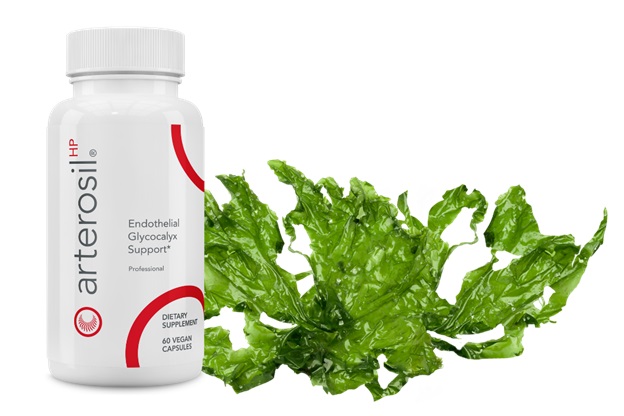
Arterosil HP is my preferred endothelial glycocalyx support,* in part due to its unique proprietary extract of rhamnan sulfate from the rare green seaweed Monostroma nitidum.
Arterosil HP contains MonitumRSTM, which is Calory’s proprietary extract of rhamnan sulfate that they get from a rare green seaweed called Monostroma nitidum. Rhamnan sulfate has been studied a lot for its benefits to cardiovascular health. There’s also been a specific in vitro study of MonitumRS by an independent third-party laboratory. Sure enough, scientists showed that the extract directly protects and restores the EGX.†
Specifically, researchers found that MonitumRS restored glucose-damaged human EGX cells up to 103.8% of their pre-damaged state, and it pulled this off in less than 24 hours†.
Since Calroy introduced Arterosil HP, other glycocalyx dietary supplements have come on the market. But I’ve yet to see one of them with this caliber of supporting evidence: direct testing of the core ingredient on living, human endothelial glycocalyx cells.†
In addition to MonitumRS, Arterosil HP contains a blend of fruit, vegetable, and green tea extracts, all included for their antioxidant properties to complement the benefits of MonitumRS by combating oxidative stress.
I’ve learned that millions of dollars and over 20 years of R&D went into creating Arterosil HP, and I can assure you it’s safe to consume (as long as you aren’t allergic to any of the ingredients, of course). With thousands of people using the supplement, no one has reported contraindications or serious side effects.
Vascanox HP
Next up is Vascanox HP.
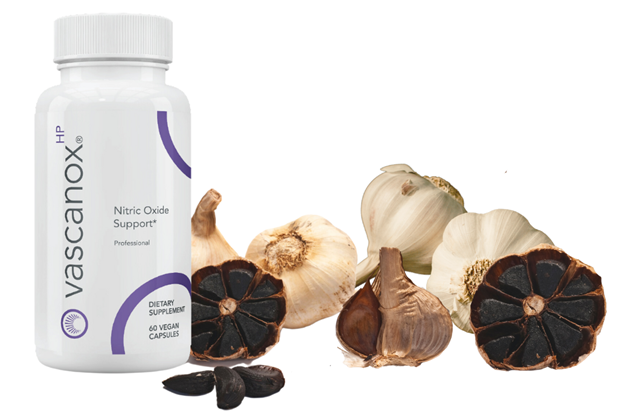
Vascanox HP contains a next-generation formula for nitric oxide support,* including black garlic extract.
Calroy really cracked the code with this product. Until now, no one could figure out how to provide nitric oxide support as and when the body needs it for more than a few hours at a time. Vascanox HP does just that — it demonstrates elevated nitric oxide for up to 24 hours*††.
If you want to be a functioning human, your body always needs optimum blood flow, not just for a few hours a day. Vascanox HP is the first NO supplement I’ve seen that has been shown to support healthy levels of NO for up to 24 hours††. It does this with a special formulation it contains called Noxa24.
You’ll recall that NO is produced in the body through multiple pathways. One of the strengths of Vascanox HP is that it addresses multiple pathways, with synergistic effects*.
Now let’s take a moment to recall the first of these pathways. The endothelial pathway involves another signaling molecule, which may turn out to be as important as NO. That’s hydrogen sulfide (H2S). The two work in tandem, and you don’t get optimum production of NO without adequate H2S. The Noxa24 formulation in Vascanox HP is unique because it supports the natural production of H2S along with NO, so they both work together for sustained cardiovascular health*.
By the way, in case you’re skeptical (and you should be about any unusual claims) you can test the effectiveness of Vascanox HP very easily.
There are nitric oxide salivary strips you can place in your mouth that immediately show the presence or absence of sufficient NO in your body. Test before and 2 hours after taking your nitric oxide product, and 24 hours later.
Recap: What You Need to Remember
Alright, my friend, hats off to you! You’ve just navigated a marathon through the system you should treat like gold — your vascular system. This isn’t just a part-time gig; it’s your lifeline, 24/7, with no breaks. You’re now wielding more knowledge about it than the average Joe, and guess what? Some of this information is like a hidden treasure (even in the medical realm).
So, now what?
Armed with this powerhouse of information, you’re not just a spectator — you’re in the game. Guard yourself against future hurdles and, even better, elevate your game both physically and mentally.
How? By giving your vascular system the love it deserves. Now you’re in the know — from the tips of your toes to the crown of your head, a river of healthy blood flow is your golden ticket to a thriving, lengthy life.

†As demonstrated in an independent third-party laboratory in vitro study.
††As measured by saliva NO test strips in an open-label published study.
